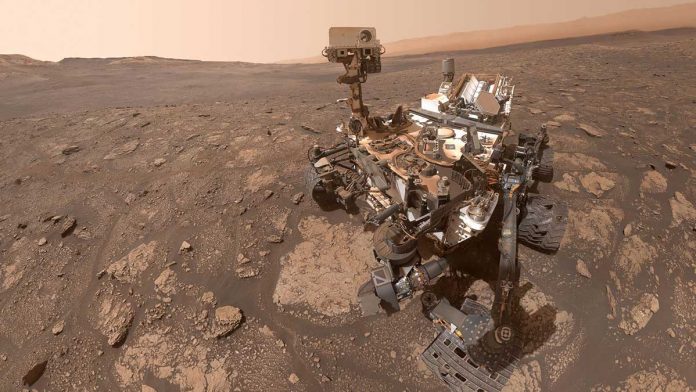According to a new NASA laboratory experiment, rovers may need to dig 6.6 feet (two metres) or more beneath the Martian surface to find evidence of ancient life because ionising radiation from space degrades small molecules like amino acids relatively quickly.
Life and non-biological chemistry can both produce amino acids. Finding specific amino acids on Mars, on the other hand, would be considered a possible sign of ancient Martian life because they are widely used by terrestrial life as a component to build proteins. Proteins are necessary for life because they are used to create enzymes that speed up or regulate chemical reactions, as well as structures.
“Our findings suggest that cosmic rays destroy amino acids at much faster rates than previously thought in Martian surface rocks and regolith,” said Alexander Pavlov of NASA’s Goddard Space Flight Center in Greenbelt, Maryland. “Current Mars rover missions can drill to a depth of about two inches (around five centimeters). It would only take 20 million years to completely destroy amino acids at those depths. The addition of perchlorates and water accelerates the destruction of amino acids even more.” A 20-million-year time span is relatively short because scientists are looking for evidence of ancient life on Mars’ surface that would have existed billions of years ago when Mars was more like Earth.
This finding suggests a new search strategy for missions that can only sample at shallow depths. “Shallow drill sampling missions must seek recently exposed outcrops, such as recent microcraters with ages less than 10 million years or material ejected from such craters,” said Pavlov, lead author of a paper on this research published June 24 in Astrobiology.
Cosmic rays are high-energy particles (primarily protons and helium ions) produced by powerful solar and deep-space events such as solar flares and exploding stars. When they penetrate yards (metres) into solid rock, ionising and destroying everything in their path, they can degrade or destroy organic molecules.
Most cosmic rays are deflected by the Earth’s thick atmosphere and global magnetic field. Mars had these characteristics in its youth as well, but lost them as it aged. However, there is evidence that the thicker atmosphere allowed liquid water to persist on Mars’ surface billions of years ago. Because liquid water is required for life, scientists want to know if life evolved on Mars and look for evidence of ancient Martian life by looking for organic molecules like amino acids in Mars rocks.
To simulate conditions in Martian soil, the team mixed several types of amino acids in silica, hydrated silica, or silica and perchlorate, and sealed the samples in test tubes under vacuum conditions to simulate the thin Martian air. Some samples were kept at room temperature, which is about as warm as the surface of Mars ever gets, while others were chilled to a more typical minus 67 degrees Fahrenheit (minus 55 degrees Celsius). The samples were bombarded with varying levels of gamma radiation—a type of highly energetic light—to simulate cosmic-ray doses equivalent to about 80 million years of exposure in Martian surface rocks.
This is the first experiment to combine amino acids with simulated Martian soil. Previous experiments used gamma radiation on pure amino acid samples, but a large cluster of a single amino acid in a billion-year-old rock is highly unlikely.
“Our work is the first comprehensive study in which the destruction (radiolysis) of a wide range of amino acids was studied under a variety of Mars-relevant factors (temperature, water content, perchlorate abundance) and radiolysis rates were compared,” Pavlov explained. “It turns out that adding silicates, particularly silicates with perchlorates, greatly increases the rates of amino acid destruction.”
While amino acids have not yet been discovered on Mars, they have been found in meteorites, including one from Mars. “We did identify several straight-chain amino acids in the Antarctic Martian meteorite RBT 04262 in the Astrobiology Analytical Lab at Goddard that we believe originated on Mars (not contamination from terrestrial biology),” said Danny Glavin, a co-author of the paper at NASA Goddard. “Because meteorites from Mars are typically ejected from depths of at least 3.3 feet (one metre) or greater, the amino acids in RBT 04262 may have been shielded from cosmic radiation.”
Organic matter was discovered on Mars by NASA’s Curiosity and Perseverance rovers, but it is not conclusive evidence of life because it could have been produced by non-biological chemistry. Furthermore, the experiment results imply that the organic material observed by these rovers has been altered over time by radiation and is thus not as it was when formed.

